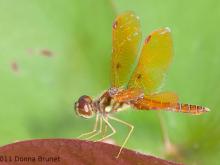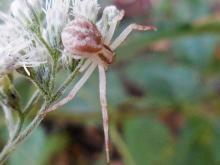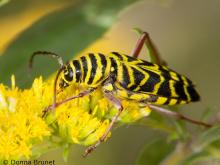Land Invertebrates
Media

Species Types
Scientific Name
Perithemis tenera
Description
The eastern amberwing is a tiny species of dragonfly that only reaches about 1 inch in length. Each of the four amber-colored wings has a red spot on the outer leading edge.
Media

Species Types
Scientific Name
Pachydiplax longipennis
Description
Blue dasher males and females look quite different. Both have a white face, a black abdomen tip, and slanted black and yellow stripes on the thorax. But males are blue and females are striped black and yellow.
Media

Species Types
Scientific Name
Tramea lacerata
Description
The black saddlebags is a dragonfly with memorable markings. Two dark blotches on each hindwing look like saddlebags.
Media

Species Types
Scientific Name
Libellula pulchella
Description
The twelve-spotted skimmer has twelve brown wing spots. Males, like this one, have eight additional spots that are white. Females lack the white spots.
Media

Species Types
Scientific Name
Mecaphesa asperata
Description
The northern crab spider has many spiny hairs covering the top surfaces of the carapace, abdomen, and legs, and it has usually has greenish-yellow or yellow-brown markings.
Media

Species Types
Scientific Name
Mecaphesa celer (formerly Misumenops celer)
Description
The swift crab spider has many spiny hairs covering the top of its body and legs, and it often has a light pinkish-tan cast.
Media

Species Types
Scientific Name
Misumessus oblongus (formerly Misumenops oblonga)
Description
The green crab spider has spines, and the entire body and legs are pale green to silvery white. Like other crab spiders, its legs extend outward from the sides, and it can walk in any direction.
Media

Species Types
Scientific Name
Charidotella sexpunctata
Description
The golden tortoise beetle is shiny metallic gold or orange, and the edges of the elytral shields are transparent. It eats plants in the morning glory family.
Media

Species Types
Scientific Name
Megacyllene robiniae
Description
The locust borer is a longhorned beetle whose larvae tunnel into the trunks of black locust. The colorful black and yellow adults are often seen in late summer as they feed on the pollen of goldenrod and other flowers.
Media

Species Types
Scientific Name
Poecilopompilus algidus and P. interruptus
Description
Poecilopompilus spider wasps provision their nests with orbweaver spiders. They dig nest burrows into the ground and therefore prefer sandy or other workable substrates.
See Also



Media

Species Types
Scientific Name
Cisseps fulvicollis
Description
The yellow-collared scape moth is more often “orange-collared.” And whether you think it looks more like a firefly or a wasp, it’s still a moth!
Media

Species Types
Scientific Name
Nearly 150 species in North America north of Mexico
Description
Slim, delicate plume moths are instantly recognizable by their T-shaped silhouette, long legs, and muted shades of tan and brown. It can be hard to separate the various species.
Media

Species Types
Scientific Name
Pyrrharctia isabella
Description
Not many people know the adult Isabella tiger moth when they see one, but we’re all acquainted with its caterpillar, the woolly worm, or woolly bear.
About Land Invertebrates in Missouri
Invertebrates are animals without backbones, including earthworms, slugs, snails, and arthropods. Arthropods—invertebrates with “jointed legs” — are a group of invertebrates that includes crayfish, shrimp, millipedes, centipedes, mites, spiders, and insects. There may be as many as 10 million species of insects alive on earth today, and they probably constitute more than 90 percent all animal species.





















